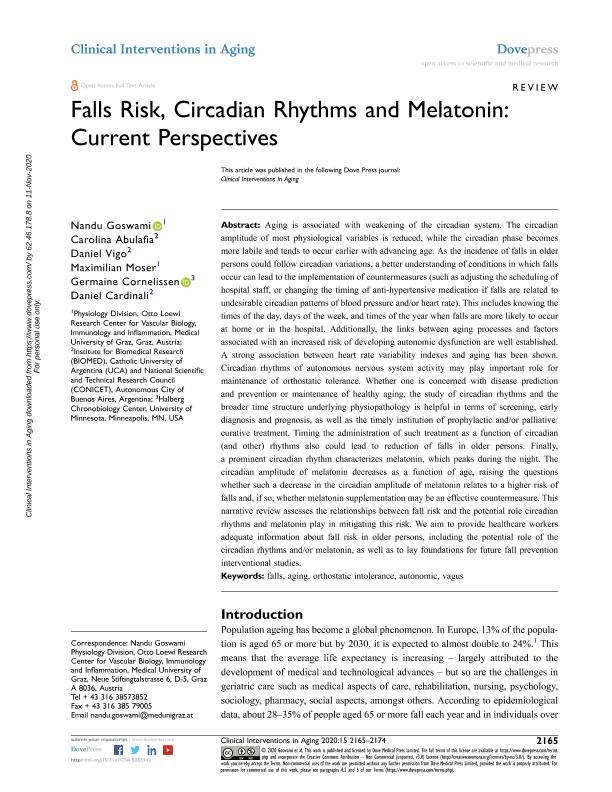Artículo
Falls Risk, Circadian Rhythms and Melatonin: Current Perspectives
Goswami, Nandu; Abulafia, Carolina Andrea ; Vigo, Daniel Eduardo
; Vigo, Daniel Eduardo ; Moser, Maximilian; Cornelissen, Germaine; Cardinali, Daniel Pedro
; Moser, Maximilian; Cornelissen, Germaine; Cardinali, Daniel Pedro
 ; Vigo, Daniel Eduardo
; Vigo, Daniel Eduardo ; Moser, Maximilian; Cornelissen, Germaine; Cardinali, Daniel Pedro
; Moser, Maximilian; Cornelissen, Germaine; Cardinali, Daniel Pedro
Fecha de publicación:
11/2020
Editorial:
Dove Press
Revista:
Clinical Interventions in Aging
ISSN:
1178-1998
e-ISSN:
1178-1998
Idioma:
Inglés
Tipo de recurso:
Artículo publicado
Clasificación temática:
Resumen
Aging is associated with weakening of the circadian system. The circadian amplitude of most physiological variables is reduced, while the circadian phase becomes more labile and tends to occur earlier with advancing age. As the incidence of falls in older persons could follow circadian variations, a better understanding of conditions in which falls occur can lead to the implementation of countermeasures (such as adjusting the scheduling of hospital staff, or changing the timing of anti-hypertensive medication if falls are related to undesirable circadian patterns of blood pressure and/or heart rate). This includes knowing the times of the day, days of the week, and times of the year when falls are more likely to occur at home or in the hospital. Additionally, the links between aging processes and factors associated with an increased risk of developing autonomic dysfunction are well established. A strong association between heart rate variability indexes and aging has been shown. Circadian rhythms of autonomous nervous system activity may play important role for maintenance of orthostatic tolerance. Whether one is concerned with disease prediction and prevention or maintenance of healthy aging, the study of circadian rhythms and the broader time structure underlying physiopathology is helpful in terms of screening, early diagnosis and prognosis, as well as the timely institution of prophylactic and/or palliative/ curative treatment. Timing the administration of such treatment as a function of circadian (and other) rhythms also could lead to reduction of falls in older persons. Finally, a prominent circadian rhythm characterizes melatonin, which peaks during the night. The circadian amplitude of melatonin decreases as a function of age, raising the questions whether such a decrease in the circadian amplitude of melatonin relates to a higher risk of falls and, if so, whether melatonin supplementation may be an effective countermeasure. This narrative review assesses the relationships between fall risk and the potential role circadian rhythms and melatonin play in mitigating this risk. We aim to provide healthcare workers adequate information about fall risk in older persons, including the potential role of the circadian rhythms and/or melatonin, as well as to lay foundations for future fall prevention interventional studies.
Palabras clave:
AGING
,
AUTONOMIC
,
FALLS
,
ORTHOSTATIC INTOLERANCE
,
VAGUS
Archivos asociados
Licencia
Identificadores
Colecciones
Articulos(BIOMED)
Articulos de INSTITUTO DE INVESTIGACIONES BIOMEDICAS
Articulos de INSTITUTO DE INVESTIGACIONES BIOMEDICAS
Citación
Goswami, Nandu; Abulafia, Carolina Andrea; Vigo, Daniel Eduardo; Moser, Maximilian; Cornelissen, Germaine; et al.; Falls Risk, Circadian Rhythms and Melatonin: Current Perspectives; Dove Press; Clinical Interventions in Aging; 15; 11-2020; 2165-2174
Compartir
Altmétricas



